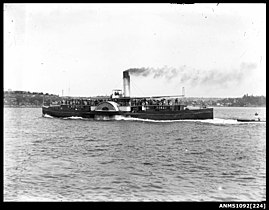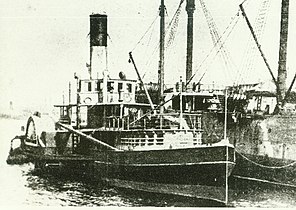
Manly ferry services operate on Sydney Harbour connecting the Sydney suburb of Manly with Circular Quay in the CBD a journey of seven nautical miles.

The SS South Steyne is a former Manly ferry on Sydney Harbour. She was the world's largest steam-powered passenger ferry and operated on the service from 1938 to 1974. Restored in the 1980s, she served as a restaurant ship in Newcastle in the 1990s, and in 2000 was moved back to Sydney and open to the public at Darling Harbour. Since April 2016 she has been stored at Berrys Bay. She was added to the New South Wales State Heritage Register on 2 April 1999.

Burra Bra was a Manly ferry on Sydney Harbour that operated by the Port Jackson & Manly Steamship Company from 1908 until 1940, before being requisitioned by the Royal Australian Navy for use as an anti-submarine training vessel and target tow during World War II.

MV Baragoola was a ferry formerly operated by the Port Jackson & Manly Steamship Company and its successors on the Manly service.

PS Brighton was a ferry used on the Sydney to Manly run. The biggest Manly ferry at the time and the largest paddle steamer to operate on Sydney Harbour, she was well-appointed and popular with passengers.
Sydney Ferries Limited operated ferry services on Sydney Harbour from 1900 until June 1951.

Bellubera was a ferry operated by the Port Jackson & Manly Steamship Company on the Manly service. Launched in 1910, she was the third of six "Binngarra-type" vessels. Upon her 1936 conversion from steam power, she became the first diesel-electric vessel in Australia. She was decommissioned in 1973, and scuttled at sea in 1980.

Karrabee was a ferry operated by Sydney Ferries Limited and its NSW State Government operated successors on Sydney Harbour from 1913 until 1984. A wooden ferry built at the time of Sydney Ferries' rapid early twentieth century, she and near "sister", Karingal, were the smallest of the fleet of round-end "K-class ferries".
Experiment was one of the first ferries servicing the Sydney Cove to Parramatta run, and later became Brisbane's first ferry.

Binngarra was a ferry operated by Port Jackson & Manly Steamship Company on the Manly service. Launched in 1905, she was the first of six similar vessels built for the company–the Binngarra class—the success of which saw three of her sister vessels serving through to the 1970s and 1980s.
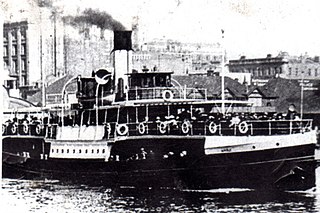
Manly (II) was a ferry that served on the Sydney to Manly run from 1896 to 1924.

The Kirrule-type ferries - Kiandra, Kirrule and Kubu - were three identical K-class ferries that operated on Sydney Harbour by Sydney Ferries Limited.
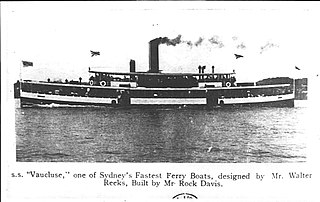
Vaucluse was a ferry on Sydney Harbour that served on the Circular Quay to Watsons Bay run. She was launched in 1905, and was one of the fastest ferries in Sydney. She was sent to Newcastle after which her fate is unknown.

Phantom was an iron paddle steamer on Sydney Harbour that ran the Circular Quay to Manly run. Built in 1858, she was the first large double-ended Manly ferry, a basic configuration that has continued through to the contemporary Manly ferries.
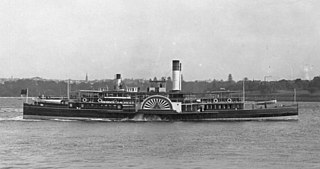
Emu, later Brightside, was an iron-hulled paddle steamer that was built in Scotland in 1864 for using in Australia. For her first few years, she worked on the Brisbane River and Moreton Bay. From 1868, she was a local ferry in Sydney Harbour. From 1902, she was a cargo ship. She was scrapped in Sydney in 1909.

Narrabeen was a paddle steamer ferry on Sydney Harbour that ran on the Circular Quay to Manly route.

Lady Edeline was a Sydney Harbour ferry built in 1913 for the Balmain New Ferry Company. She and four similar ferries, Lady Chelmsford (1910), Lady Denman (1912), Lady Ferguson (1914), Lady Scott (1914) were a new series of "Lady-class", designed by renowned naval architect, Walter Reeks.

Kareela was a "K-class" ferry on Sydney Harbour. Launched in 1905, the double-ended timber-hulled steamer was built for Sydney Ferries Limited in response to the early twentieth century boom in cross-harbour ferry travel prior to the opening of the Sydney Harbour Bridge. She was the first of Sydney Ferries Limited's boats to have a fully enclosed upper deck.

Sydney Harbour ferry services date back to the first years of Sydney's European settlement. Slow and sporadic boats ran along the Parramatta River from Sydney to Parramatta and served the agricultural settlements in between. By the mid-1830s, speculative ventures established regular services. From the late-nineteenth century the North Shore developed rapidly. A rail connection to Milsons Point took alighting ferry passengers up the North Shore line to Hornsby, New South Wales via North Sydney. Without a bridge connection, increasingly large fleets of steamers serviced the cross harbour routes and in the early twentieth century, Sydney Ferries Limited was the largest ferry operator in the world.

Kanangra is a retired ferry on Sydney Harbour. She was launched in 1912 during the early-twentieth century pre-Sydney Harbour Bridge boom years of Sydney Ferries Limited.

